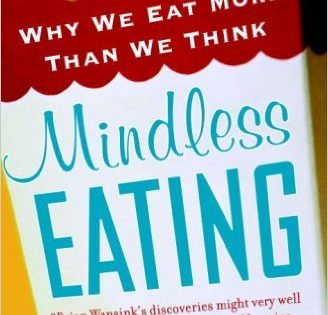“Mindless Eating – Why We Eat More Than We Think” by Brian Wansink
If you are looking for a way to lose some weight but don’t want to make huge changes to your diet/life, then I highly recommend reading this book. It’s a a quick and easy read about the subconscious influences that affect how, what, & why we eat.
As a physical therapist, I am able to interact and converse with patients a lot more than other healthcare professionals and really get to know patients. Frequently, patients bring up the topic of weight loss and are looking for advice. By no means am I a nutritionist, so I don’t recommend any actual food changes to patients’ nutritional habits (I know my limitations and leave the nutritional side of things up to the experts).
What I try to do is talk about how food factors into a person’s daily behaviors/habits and figure out simple changes that someone can make to help them achieve their goals. I emphasize keeping it simple because if you try to make huge changes and do too much, it usually doesn’t work out well. This book has provided valuable insight into this idea and given me even more possible areas to discuss with my patients.
“Mindless Eating” provides plenty of these simple changes that subconsciously (or mindlessly) affect how much food we eat, the type of food, the taste of food, etc. Brian uses lots of experiments and real-life examples that make the book easy to relate to and easy to read. If you cut out 100 calories a day (which you can easily do without even realizing it), you will lose 10 pounds in a year. Even if you don’t have weight issues, I still recommend reading the book because it will make you more knowledgeable about eating habits – which is always a good thing to know. You can use that info to potentially save money when purchasing food/eating out, to gain weight (I’m thinking about people who don’t eat enough when training), to develop good eating habits for your family/children (personally, this is where I look to implement many of the ideas in this book), to eat more nutritious, etc.
Because the book talks about subconscious factors it might be hard to think about what it could discuss, so here is a very brief description of what each chapter discusses:
Chapter 1 – Intro – “The best diet is the one you don’t know you’re on”
Chapter 2 – The effect vision (seeing what you’re going to eat and what you’ve already eaten) has on eating habits
Chapter 3 – How plate size, glass size, package size, etc effects eating habits
Chapter 4 – The “see-food” trap – if we see food, we usually eat food (the more of a hassle it is to eat, the less we eat)
Chapter 5 – Eating scripts – how television, friends, weather, restaurant atmosphere, smell affect how we eat
Chapter 6 – We taste what we expect we’ll taste – how name, description, etc affect our perception of food
Chapter 7 – Controlling comfort foods – how to not deprive yourself of them and “rewire” our thoughts on comfort foods
Chapter 8 – Nutritional gatekeepers – how one person usually affects the entire nutrition for a family
Chapter 9 – Discusses the fast-food industry
Chapter 10 – How to put it all together
After reading each chapter, I recommend that you write down 2-3 things that you could change in your life (or patients, clients, etc) and by the end of the book, you will have a list of easy-to-implement ideas that can help you reach your goals.
Here is a link to the book on amazon – and for the record, I do not get any financial benefit if you buy the book…just trying to help you out.
